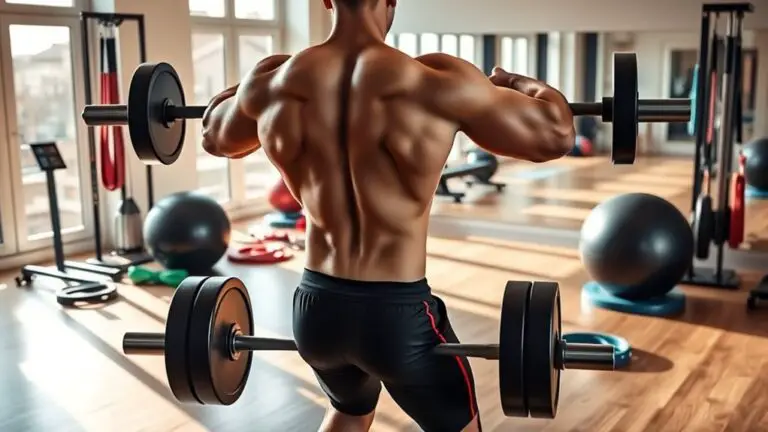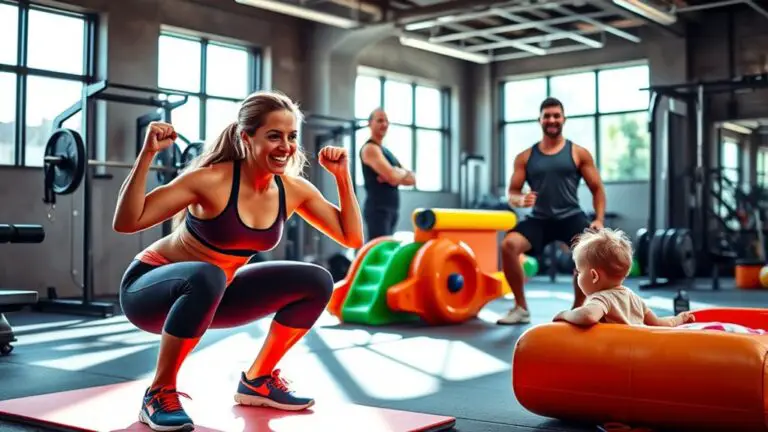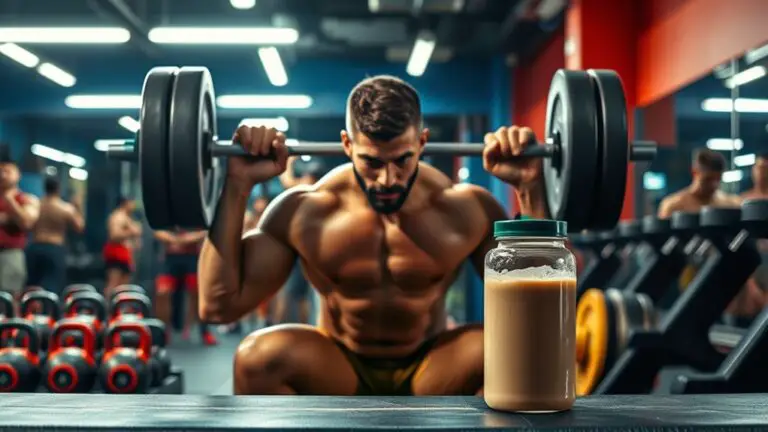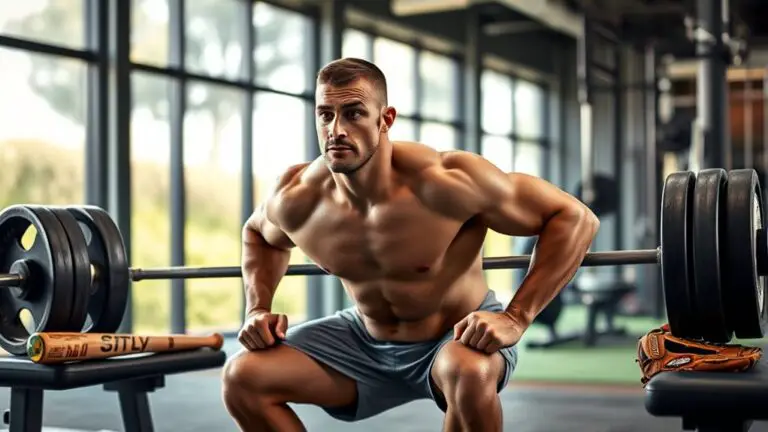The Best Gym Exercises for Women Who Want to Build Glutes
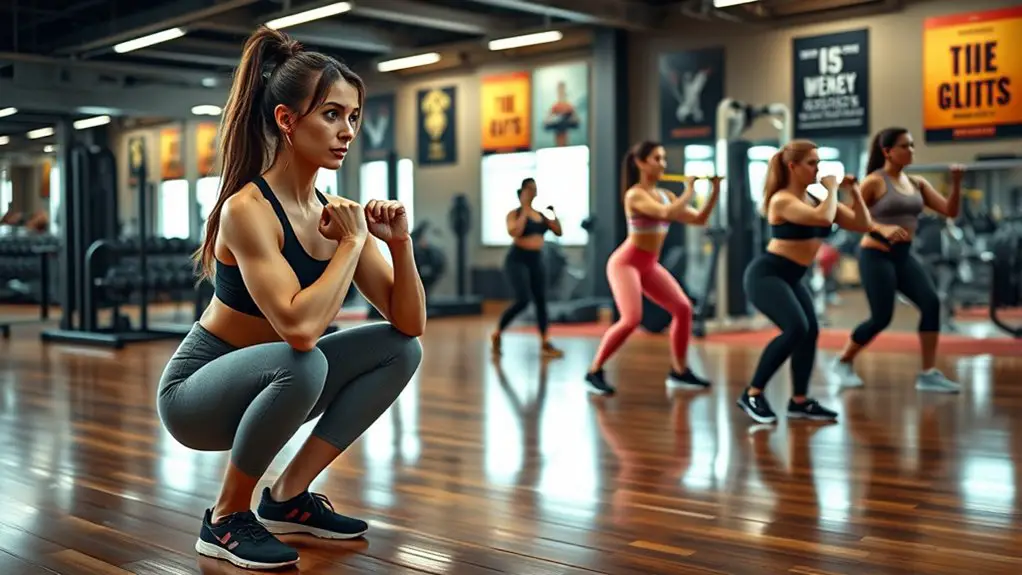
To build stronger, shapelier glutes, you should incorporate exercises like squats, deadlifts, lunges, and hip thrusts into your routine. Aim for variations of each move to target your glutes from different angles. Don’t forget to include step-ups for strength and stability, plus cable kickbacks for isolation. Focus on form and challenge yourself for the best results. Keep going, and you’ll discover even more effective strategies to enhance your glute development.
Squats: The Foundation for Glute Growth

When it comes to building strong, shapely glutes, squats are often considered the foundation of any effective workout routine. By incorporating various squat variations into your regimen, you can target different muscle fibers and keep your workouts dynamic. Whether you opt for bodyweight squats, goblet squats, or barbell squats, each variation has unique benefits that contribute to glute growth. Don’t underestimate the importance of squat depth, either. Going lower can engage more of your glute muscles, but it’s vital to maintain proper form to avoid injury. Aim for a depth that feels comfortable while still challenging you. Additionally, incorporating a powerful exercise like skipping rope can enhance overall fitness and support your weight loss goals, complementing your glute-building efforts.
Deadlifts: Unlocking Your Glute Power
When it comes to building strong glutes, mastering proper deadlift form is your key to success. Not only will it help you activate those muscles effectively, but exploring deadlift variations can also keep your workouts fresh and exciting. Let’s release your glute power and elevate your fitness game!
Proper Deadlift Form
The deadlift is a powerhouse move that can greatly enhance your glute strength when performed with proper form. To start, stand with your feet hip-width apart, barbell close to your shins. Bend at your hips and knees, grip the bar, and keep your back straight. As you lift, engage your core and push through your heels, bringing your hips forward. This guarantees you’re maximizing the deadlift benefits, focusing on your glutes. Lower the bar in a controlled manner, maintaining that straight back. Remember, mastering proper form is essential before exploring deadlift variations. With practice, you’ll not only build stronger glutes but also boost overall strength and confidence in your workouts! Keep pushing; you’ve got this!
Deadlift Variations Explained
While many people are familiar with the classic deadlift, exploring its variations can reveal even greater glute power and enhance your overall fitness routine. Incorporating different deadlift variations not only maximizes deadlift benefits but also keeps your workouts fresh and engaging. Here are some popular variations to evaluate:
| Deadlift Variation | Targeted Muscles | Benefits |
|---|---|---|
| Conventional Deadlift | Glutes, Hamstrings, Back | Builds overall strength |
| Sumo Deadlift | Glutes, Inner Thighs | Focuses on glute activation |
| Romanian Deadlift | Hamstrings, Glutes | Improves flexibility |
| Single-Leg Deadlift | Glutes, Core | Enhances balance and stability |
Lunges: Targeting Each Glute Muscle

Lunges are a fantastic way to target each glute muscle while also improving your overall strength and stability. You’ll want to explore different types of lunges, master proper form techniques, and steer clear of common mistakes to maximize your results. Let’s break down how to get the most out of this essential exercise!
Types of Lunges
Incorporating different types of lunges into your workout routine can greatly enhance glute development. Start with forward lunges to engage your glutes and quads, then switch to reverse lunges for a different muscle focus. Lateral lunges can help build strength across your hips, while curtsy lunges target those tricky outer glutes. Walking lunges are fantastic for endurance, and Bulgarian lunges really amplify intensity. For a high-energy option, try plyometric lunges to fire up your glutes and boost cardio. Weighted lunges add resistance, increasing muscle engagement, while static lunges guarantee you’re concentrating on form. Finally, rotational lunges can incorporate your core, making this a powerhouse move for overall strength. So, mix it up and challenge yourself!
Proper Form Techniques
To effectively target each glute muscle during lunges, you’ll want to prioritize proper form to maximize your results and prevent injury. Start by standing tall, feet hip-width apart, and step forward with one leg, ensuring your knee doesn’t extend past your toes. Lower your body until both knees are at about 90 degrees, keeping your chest up and core engaged. Remember, proper breathing is key—inhale as you lower and exhale as you push back up. Focus on muscle engagement, feeling your glutes activate as you rise. By maintaining this form, not only do you enhance your glute development, but you also build strength and stability. Keep pushing, and you’ll see those results!
Common Mistakes to Avoid
While lunges are an excellent exercise for building glutes, many people make common mistakes that can hinder their progress and lead to injury. Understanding these common misconceptions and avoiding improper techniques is essential for effective workouts. Here are some key mistakes to watch out for:
- Failing to keep your front knee aligned over your ankle
- Leaning too far forward, which shifts the focus away from your glutes
- Not engaging your core, reducing stability and effectiveness
- Rushing through the movement, compromising form and results
Hip Thrusts: Maximizing Glute Activation
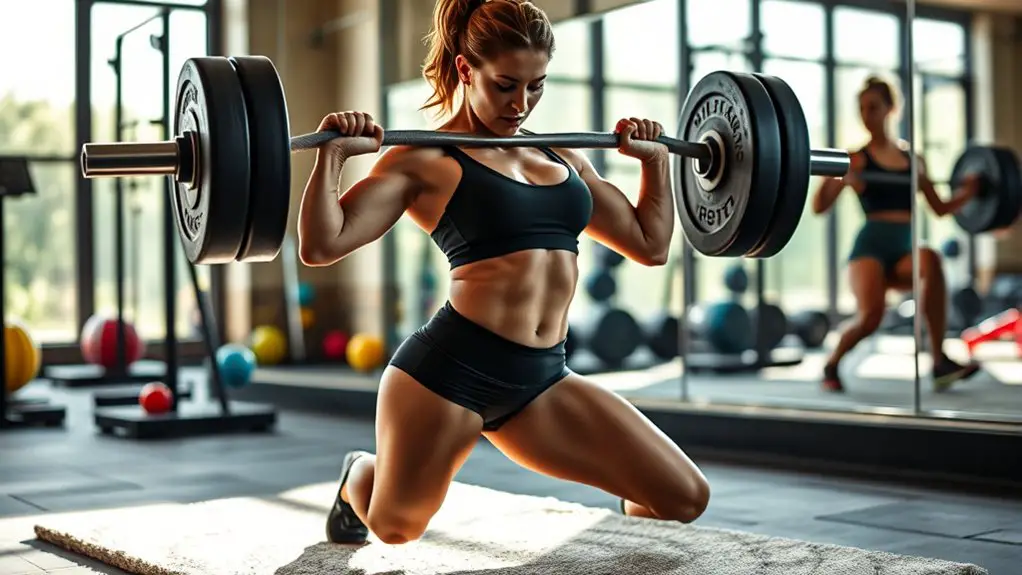
Release the power of hip thrusts to maximize your glute activation and transform your workouts. This exercise effectively targets your glutes, but you can take it further with hip thrust variations. Experiment with single-leg thrusts for added difficulty, or try using a barbell for increased resistance. Don’t forget to focus on glute activation techniques, like squeezing your glutes at the top of the movement and holding for a brief moment.
Proper form is essential; guarantee your shoulders are on a bench and your feet are flat on the ground. Engage your core to stabilize your body throughout the exercise.
Incorporating hip thrusts into your routine can lead to impressive results, so stay consistent and challenge yourself. Remember, it’s not just about lifting weights; it’s about feeling those glutes working! With dedication, you’ll reveal your glute potential and enhance your overall strength.
Glute Bridges: A Simple Yet Effective Exercise
If you’re looking for a simple yet effective way to strengthen your glutes, glute bridges are an excellent choice. This versatile exercise is great for all fitness levels and can easily be modified with various glute bridge variations to keep your routine fresh and challenging.
Here are some benefits of glute bridges:
- Strengthens the glute muscles effectively, promoting better shape and tone.
- Improves hip mobility and flexibility, enhancing overall movement.
- Supports lower back health by stabilizing the core and reducing strain.
- Can be done anywhere, requiring no equipment for basic versions.
Incorporating glute bridges into your workout can lead to impressive results. So, whether you’re a beginner or a seasoned gym-goer, don’t underestimate the power of this simple exercise—start bridging your way to stronger glutes today!
Cable Kickbacks: Isolating the Glute Muscles

Cable kickbacks are a fantastic way to isolate and target your glute muscles, making them a staple in any glute-building routine. To perform this exercise, set up a cable machine with an ankle strap attached at the lowest setting. Stand facing the machine, secure the strap to your ankle, and step back to create tension in the cable.
As you hinge slightly at the hips, extend your leg straight back, squeezing your glutes at the top of the movement. This cable setup allows for effective muscle isolation, focusing solely on your glutes without engaging other muscle groups excessively.
Aim for 3 sets of 12-15 reps on each leg, and remember to control the movement both up and down. Incorporating cable kickbacks into your workouts will not only help you sculpt your glutes but also enhance your overall strength and stability. Keep pushing yourself—you’ve got this!
Step-Ups: Building Strength and Stability
Step-ups are one of the most effective exercises for building strength and stability in your glutes and legs. Not only do they target your glute muscles, but they also enhance your balance improvement, making them a must-try in your workout routine.
Step-ups effectively strengthen your glutes and legs while enhancing balance, making them essential for any workout routine.
Here are some great step-up variations to evaluate:
- Basic Step-Up: Focus on form and control for a strong foundation.
- Lateral Step-Up: Engage different muscles and challenge your stability.
- Weighted Step-Up: Add dumbbells for an extra challenge and to build strength.
- Reverse Step-Up: Great for targeting your glutes and hamstrings while improving coordination.
Incorporating these variations will keep your workouts dynamic and effective. Step-ups not only sculpt your glutes but also boost your overall athleticism. So, step up your game and watch your strength and stability soar! Additionally, exercises like Bulgarian Split Squat can further develop lower body strength and stability for better performance in step-ups.
Frequently Asked Questions
How Often Should I Train My Glutes Each Week?
Think of your glutes as a fine wine that needs time to breathe. Ideally, you should train them two to three times a week, allowing for adequate glute recovery in between sessions. This workout frequency guarantees you’re challenging your muscles without overdoing it. Listen to your body; if you feel sore, give yourself an extra day. Consistency is key, but so is recovery—both are essential for sculpting that perfect backside!
What Should I Eat to Support Glute Growth?
To support glute growth, you need to focus on your diet. Incorporating protein sources like chicken, fish, legumes, and dairy into your meals is essential, as they help repair and build muscle. Don’t forget about meal timing; try to eat a protein-rich meal or snack within 30 minutes post-workout to maximize recovery. Staying consistent with your nutrition can greatly enhance your results, so keep pushing towards those goals!
Can I Build Glutes Without Heavy Weights?
Can you really build impressive glutes without heavy weights? Absolutely! Bodyweight exercises like squats, lunges, and hip thrusts can be incredibly effective. Pair them with resistance bands to increase intensity and activate those muscles even more. By focusing on form and consistency, you’ll see progress in no time. Just remember, it’s all about finding what works for you and staying motivated. So, get started today and watch your glutes grow!
Should I Prioritize Glute Workouts Over Other Muscle Groups?
When considering whether to prioritize glute workouts over other muscle groups, it’s essential to think about muscle balance. Focusing on glute activation is important for overall strength and stability, but neglecting other areas can lead to imbalances. You’ll want to incorporate a well-rounded routine that strengthens your entire body. This way, you’ll not only build impressive glutes but also enhance your performance and prevent injuries. Remember, balance is key for long-term success!
How Long Before I See Results in My Glutes?
You’re on a journey to sculpt those gorgeous glutes, and results will bloom with patience. Typically, you might notice some glute activation within a few weeks, but real transformations often take a couple of months. Remember, muscle recovery is key, so give your body time to adapt and grow. Stay consistent, and you’ll see those curves start to emerge, turning your hard work into a stunning reality. Keep pushing forward, you got this!
